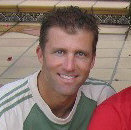
Matt Holt was kind enough to share his nitty gritty insights on the Da Vinci Code of American Tennis. Matt Holt was formerly a top US junior, earned a scholarship to Pepperdine and Arizona, and currently shares his teachings with his students in the San Francisco area. Very thought provoking and entertaining at the very least.
I believe today's coaches as a general rule are extremely skilled in developing players and are very passionate. Having grown up in the 70's and 80's playing, practice sessions were amazing but coaching was relatively mediocre. I had some really wonderful coaching, but I think technology and information sharing has lead to many instructors and coaches having access to effective and accurate info.
That being said, practices today are mediocre at best. I feel coaches are incredibly limited due to parents that can micro-manage, children that are totally overscheduled, and practice regimens that in no way represent tournament scenarios. I have parents ask me all the time what path I recommend for their child's development based on their skill level, desire, and academic/life goals. I always evaluate and give them my opinion, but in my mind I am in a state of shock.
Growing up in the 70's/80's when tennis was at a peak (like it is hopefully growing at the moment), the path to success hit you smack in the face. There were no clinics and large group lessons. If you were lucky, you had a private lesson each week, and then you got out on the courts and played your ass off against the best players you could every week! You played kids and adults alike, and you had exposure to every style of play. The pecking order was across all players... men, women, boys, girls. You had to beat player x before player y would play you. It was incredibly competitive, but at the same time there was a ton of comraderie. We always cheered for all of the players from our club, kind of like an unofficial team. The competition built respect for one another. It was never hard to prepare for a tournament because you were playing several matches per week. Mental toughness was far more developed than is seen currently among American players.
As a coach who obviously relies on some degree of group lessons in order to drive profitability for a department, I have always advocated for juniors to go out and play as much as possible and not attend all clinics. Save a buck and call your friends to set up matches. It is incredible to see how many of these players go take a lesson from another coach or come back to a clinic rather than going out to practice and compete against anyone. The culture is really lacking when it comes to that. I wish I could identify the root cause for this, but I know it's not the players' fault. Maybe it's that there is so much overall focus with school and sports that the clinics provide a much needed social forum. I think this is partially true, but there has to be some grit out there that can only be attained through rigorous competition.
Sitting on boards and committees, I have heard all of the arguments for lack of American champions in recent years. While I can't deny that, I can say that almost all of the traditional countries who have dominated the sport face the same fate. It is too much hard work relative to other things to excel at the sport. In countries where standards of living are slightly lower to definitely lower, the work to aspire in any profession is significant. Hence, the drive to succeed is on par with that of many career choices.
It will take some unique individuals to put American tennis back in the limelight. There is some really nice talent out there at the moment, and I think there will be a much deeper pool over the next 6-8 years. In any case, we are a global society and there is some awesome tennis being played out there at the moment! I haven't seen a 4-pack of men hanging in the top since Borg, Mac, Connors, Vilas. I hope we get another 2 years out of this foursome. On the ladies' side, I have been excited at all of the new faces and I feel the level of play has improved drastically over the past 18 months. WTA needs a more targeted marketing campaign. They need a top rivalry, but the product is much better than they are getting credit for.
 Tuesday, November 29, 2011 at 07:59PM
Tuesday, November 29, 2011 at 07:59PM  CAtennis
CAtennis 




